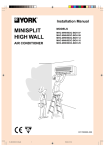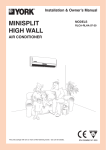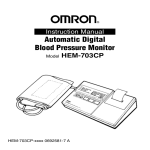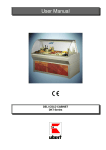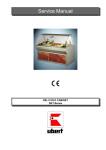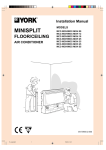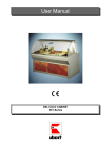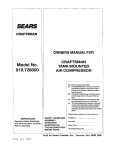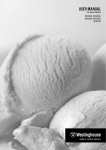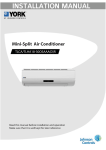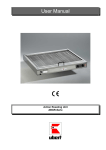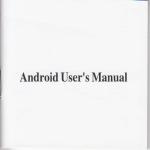Download York BOC-BOH 25 Owner`s manual
Transcript
EN/FR ENGLISH ∞ Do not conduct installation in wet area or in the rain. ∞ This system is designed for domestic or residential use only. It is a high risk to cause the electrical shocks. If used in certain envionments, such as a manufacturing workplace, the equipment may not function efficiently. 035T83007-000 INSTALLATION & OWNER’S MANUAL MINISPLIT HIGH WALL AIR CONDITIONER MODELS : MHC-MHH/BOC-BOH 07-35 n WARNING Failure to follow a warning may result in death or serious injury. n CAUTION Failure to follow a caution may result in serious injury or property damage, and in certain conditions, may result in a grave consequence • Electrical connections All electrical wiring and connections must comply with local codes and standards. Power supply cord and interconnection cord used must not be lighter than Polychloroprene sheated cord (245 IEC 57 or H05RN-F). Disconnecting device must have a contact separation of at least 3 mm. • The following symbols are often used in this manual. REQUIRED TOOLS Strictly prohibited. 1. 2. 3. 4. 5. 6. 7. 8. 9. 10. 11. 12. 13. 14. 15. Screw driver Hexagonal wrench Torque wrench Spanner Reamer Hole core drill Tape measure Thermometer Manifold Guage Gas leak detector Vaccum pump Pipe clamp Pipe Cutter Flare Tool Set Electrical Circuit tester Be sure to follow the instructions. Be sure to earth the air conditioner. Be sure to disconnect the power plug. Do not touch the air conditioner with a wet hand. Do not cause the air conditioner (including the remote controller) to get wet. _n _ WARNING Do not expose your body directly to the cool (or hot) air for prolonged period; do not cool (or hot) the room too much. If anything abnormal such as a burning smell occurs, stop the operation immediately and turn the breaker off. EXTENDED PARTS 1 Refrigerant Pipe This could effect your physical condition and cause health problems. MHC-MHH/BOC-BOH Models 07-09 12 18-35 Liquid size 1/4 inch 1/4 inch 3/8 inch Gas size 3/8 inch 1/2 inch 5/8 inch Do not put a finger, a rod or other objects into the air outlet or inlet. Do not attempt to extend the power cord by joining it to another cord, or by using an extension cord. Do not put any other loads on the power supply socket. 2 Pipe Insulation Material (Polyethylene foam 9 mm thick) 3 Vinyl tape 4 Putty SAFETY PRECAUTIONS • • Please read this installation manual carefully before starting installation of the unit. This air conditioning system contains refrigerant under pressure, rotating parts and electrical connection which may be dangerous and can cause injury. Installation and maintenance of this air conditioning system should only be carried out by trained and qualified personnel. • After unpacking, please check the unit carefully for possible damage. • Before undertaking any work on the unit, make sure that the power supply has been disconnected. Continued abnormal operation will cause troubles, electric shocks, fire etc. If anything is abnormal consult the shop where you bought the air conditioner. As a fan is rotating at a high speed, it will cause injury. Do not attempt to repair, relocate, modify or reinstall the air conditioner by yourself. Do not damage or attempt to modify the power cord. Do not use the cord in a damaged state or tie in a bundle. CAUTIONS FOR INSTALLATION ∞ Do not store or unpack the unit in a wet area or expose to rain or water. ∞ Do not install in a place where flammable gas may leak. Incorrect work will cause electric shocks, fire etc. For repairs and reinstallation, consult the shop where you bought the air conditioner. n CAUTION It may cause the unit to short circuit and may result electric shocks or fire. Before cleaning, be sure to stop the operation and turn the breaker off. Do not operate the air conditioner with a wet hand. As the fan is rotating at a high speed, cleaning during operation may cause injury. It may cause an electric shock. It may cause fire. Do not use the air conditioner for food preservation purpose. Ventilate the room from time to time. NAME OF PARTS INDOOR UNIT AAA BB B POWER ON OFF G EMERGENCY OPERATION F Be careful especially when using a burning appliance in the same room. Insufficient ventilation may cause shortage of oxygen. C CC E D Do not connect the air conditioner to a power supply different form the specification. Do not stand or sit on the outdoor unit, do not place any object on the unit. H A B C D Front Grille Air Purifying Filter Indicator Lamps Flap Vertical Blades E F G H It may cause trouble or fire. Air Outlet Air Filter Air Inlet Louver Horizontal Blades OUTDOOR UNIT After a long use, check the unit fixing for damage. Do not place a burning appliance in a place exposed to the air flow form the unit or under the indoor unit. B F A E D C Do not wash the unit with water. Do not place anything under the indoor or outdoor unit which must be kept away from moisture. Air Outlet Air Inlet Refrigerant gas piping A B C Do not place a vessel containing water on the unit. D Refrigerant liquid piping E Additional drain hose F Connecting Cable PREPARATION BEFORE INSTALLATION Do not expose plants or animals directly to the air flow. Do not block air inlets or outlets. • Before doing any work, check the interior power supply cord and the main breaker capacity are sufficient and the installation area is sufficient and comp•lies with the requirements. • Check that the power supply available agrees with nameplate voltage. • Electrical work, wiring and cables must be performed in compliance with national and local wiring codes and standard. • Do not use the extension cables. In the case extended cables are needed, use the terminal block. SELECTION OF THE LOCATION • Select a place which provides the space around the units as shown in the diagram below. PART LIST INDOOR Name of part Part No. MHC-MHH/BOC-BOH MHC-MHH/BOC-BOH MHC-MHH/BOC-BOH 07, 09, 12 18, 25 35 Mounting Plate and Mounting Template 1 Quantity X1 Indoor Unit 2 X1 Drain Hose 3 OUTDOOR X1 *Included with indoor unit Central mounting bracket 4 X1 *Not supplied Screws and Anchor Set 5 X4 Remote Control and Batteries set ˚C ˚C + + E TE — MOD — AR — SET CLE TE E + — MOD SET CLE AR — ˚C R — MP — + MP — MP + E TE — MOD — AR — CLE R SET TIME X1 ˚C — + ˚C ˚C R ˚C ˚C TIME 6 TIME ˚C MHC-MHH/BOC-BOH Models 07 Installation & Owner’s manual and user’ s guide 7 Installatio Owner's manun & al User' s Guid e Installatio Owner's manun & al User' s Guid e Installatio Owner's manun & al A User' s Guid e 09 12 18 25 MHC-MHH/BOC-BOH Models 35 60cm 60cm 60cm 60cm 60cm 60cm 07 A 09 12 18 25 35 20cm 20cm 20cm 20cm 20cm 20cm B 70cm 70cm 70cm 70cm 70cm 70cm B 60cm 60cm 60cm 60cm 60cm 60cm C 60cm 60cm 60cm 60cm 60cm 60cm C 40cm 40cm 40cm 40cm 40cm 40cm D 10cm 10cm 10cm 10cm 10cm 10cm D 20cm 20cm 20cm 20cm 20cm 20cm X1 n CAUTIONS ELECTRICAL WORK ∞ For power supply, be sure to use a separate power circuit dedicated to the air conditioner. System relocation • Do not install in a place that cannot bear the weight of the unit. 133.5 SYSTEM RELOCATION 133.5 ∞ Relocating the air conditioner requires specialized knowledge and skills. Please consult the shop where you bought the air conditioner if relocation is necessary for moving or remodelling. 230 268 248 497 INSTALLATION IN THE FOLLOWING PLACES MAY RESULT IN TROUBLE BO 07-12 517 260 316 296 144 144 BO 18 429 100 550 Installation in the unit wrong direction. Installation of outdoor units too close or, blowing discharged air into each other. Installation of the indoor unit in a place where there is an obstacle near the air inlet or outlet. Installation of the outdoor unit in a place exposed regularly to a strong wind. Installation of the indoor unit at too low a position 24 100 150 Installation of the indoor unit in direct sun light. 335 287 315 234 64 24 64 150 BO 25-35 INSTALLATION n CAUTION n WARNING The air conditioner must be earthed in accordance with the local codes. Do not install the air conditioner in places where flammable gas may leak. Incomplete earthing may result in electric shock. Do not connect the earth line to a gas pipe, lightening rod or a telephone earth line. If leaked gas should accumulate near the unit, fire may occur. Arrange the drain hose to ensure smooth drainage. Depending on the environment and local codes, an earth leakage breaker must be installed. OFF Incomplete drainage may cause wetting of the building, furniture etc. ON Consult the service shop or qualified technician. Incorrect installation will result in water leakage, electric shock or fire. For installation, consult the service shop where you bought the unit or a qualified technician. 10 cm Do not attempt to install the air conditioney yourself. INSTALLATION DIAGRAM INSTALLATION SITE 10 cm or more To install the air conditioner in the following types of environments, consult the shop. ∞ Places with an oily ambient or where steam or soot occurs. ∞ Salty or corrosive environments such as coastal areas. ∞ Places where sulfide gas occurs such as hot springs. The drain from the outdoor unit must be discharged to a place of good drainage. Installation plate 60 cm or more Remove the cover plate screw to have access to the terminal board. 60 cm or more 70 cm or more CONSIDER NUISANCE TO YOUR NEIGHBOURS FROM NOISES Auto louver (vertical) Manual louver (horizontal) For installation choose a place as described below. ∞ A place solid enough to bear the weight of the unit and which does not amplify the operation noise or vibration. ∞ A place from where the air discharged from the outdoor unit or the operation noise will not annoy your neighbours. Vinyl tape Apply after carrying out a drainage test. * To carry out the drainage test. remove the air filters and pour water into the heat exchanger. 20 Inverter-type fluoreascent lamp. A place with good ventilation. TV Air Outlet Air Inlet Conecting cable Addinonal drain hose cm or mo re 20 cm or more Liquid side piping Gas side piping To prevent interierence, place at least 1 m away. Vinyl tape Radio 60 cm or more INSTALLATION PROCEDURE Drain hose • Drain hose is flexible and can be routed to suit various piping arrangements. The drain line must include elbow trap (U bend). Connect a plastic condensate pipe with an internal diameter of 12 mm. INDOOR UNIT Fixing • Place the installation guide pattern on the designated installation place and mark the hole position. • Drill a hole and mount installation plate Note: Do not put the drain hose end into water. Ø 70 mm .. . ... ... ... ..... .. .. . ... ...... .. . ... . . .. .... .. .. . ... ...... .. . . • After determining the pipe hole position. Drill the hole at a slight downward slant towards the outdoor side. Indoor Note : When installing the refrigerant pipes from others side. A hole must be place to allow fall towards the outdoor unit. .. . ... ... ... ..... .. .. . ... ...... .. .. . ... ...... . .. .. ... ..... .. . ... .... • The drain hose can be connected to the left or the right side. For left and left rear piping For right and right rear piping Outdoor 5 • Make ø5mm. 4-6 holes, in the wall at the four corners of mouting plate (bracket) then insert appropriate mouting devices. • Install the mounting plate using 4-6 pieces of mounting screw securely at four corners and tighten the screw completely. Do not over tighten the screws and deform the back plate. Drain hose Drain cap For left and left rear piping n Caution Drain cap Drain hose Be careful when handling the sharp edge of the mounting plate. Verification of condensate water drainage: Fill the drain pan with water and observe evacuation. Wiring • This indoor unit is ready for connection to the outdoor unit. n Cautions • Never modify the unit by removing any of the safety guards or by bypassing any of the safety interlock swithces. • Connect the interconnecting cable correctly and connect the connecting cable to terminal as identified with their respective marking. • Do not damage the conductor core or inner insulation of power supply cables and do not deform or crush the cables. Indoor Unit Fixing • Thread the indoor unit piping and cable through the hole. • Hang the top of the unit onto the upper ridge of them in mounting plate. • Make sure that the unit is correctly hung in place by sliding it to the left, then to the right. • Press the bottom left and bottom right hand corners of the unit against the mounting plate until the fixing prongs click into place in the retainers provided to that effect. Piping A Right B Right C Right D Right F Ieft Drainage line E Rear buttom Interconnection cable The auxiliary piping can be connected in the diections shown the above diagram. To connect in the D, E and F direction, pipes will need to be extended. (MHC-MHH/BOC-BOH 07-25) n Cautions • Bend pipes carefully to avoid flattening or obstructing them if the pipes are bent incorrectly, the indoor unit may be unstable on the wall. • Carefully arrange pipes so that pipes do not stick out of the rear plate of the indoor unit • For the model MHC-MHH 18, 25 and 35 and install the central mounting bracket as shown in the below diagram. Refrigerant charge to be added per extra metre of piping length when more than 7.5 meters. MHC-MHH/BOC-BOH Unit size g/m 7 9 12 18 25 35 15 15 15 40 40 40 Refrigerant piping connections (FLARE connections) To avoid alteration of unit capacities, check that piping lengths and changes in elevation are kept to a strict minimum. (MHC-MHH /BOC-BOH 18, 25 and 35) Before connection the refrigerant lines, follow the procedures below (if pre-charged connection lines are not supplied): Mounting Plate - Central Mounting Bracket - Select copper pipe diameters according to the size of unit to be installed. Install the refrigeration lines, checking that no foreign boodies get inside the piping. Install the flare connectors and flare the ends of the pipes. Evacuate the piping. This operation, which should last at least 15 minutes if there are large piping lengths and changes in elevation, should be followed by a leak test. To this effect, when the piping has been evacuated, close the pressure gauge tap, note the value on the gauge, then wait for 15 minutes. If the needle moves, there is a leak in the system. Make the necessary adjustments or repairs and repeat this procedure until the needle no longer moves. Open the service valves and top up the refrigerant charge if necessary. (MHC-MHH/BOC-BOH 18, 25 and 35) Installation Minimum thickness 6 mm a a) Condensate drainage line Access plate for the condensate drainage pump detection (condensate pump is available as an accessory). Heat pump (discharge) Vinyl tape Note: The condensate evacuation line should be taped to the refrigerant lines with vinyl tape. Heat pump OUTDOOR UNIT D Fixing and Piping L Liquid Cooling Cooling (suction) • Piping must be performed by qualified personnel according to good refrigeration systems practices. • Piping materials and insulation materials must be of refrigerant quality. • Select the pipe diameters according to the size of unit and cut the pipe to design length by using pipe cutter. • Install the flare nuts and flare the end of the pipes. • Check that no foreign bodies are inside the piping. • Align the central of the connecting pipes and tighten the flare nut. • Fix piping with pipe clamps and check that any pipe vibrations cannot be transmitted to the building structure. Head pump (discharge) Heat pump Notes L Liquid • Connect the pipe correctly. • Do not apply the excessive torque. • Use an appropriate bending tool to form curves and avoid over-tightening the refrigerant tubes. • To prevent heat loss, the two lines must be insulated separately. H GASS Cooling (suction) Cooling Maximum piping lengths Unit size 7 9 12 18 25 35 Low pressure D (m) 10 12 15 15 22 22 L (m) 12 15 18 18 25 25 H (m) 7 10 12 12 20 20 High pressure Manifold Gas value Liquid value Pressure tab Note : Where the difference in elevation between the indoor unit and the outdoor unit is greater than 5 meters, install an oil trap every 5 meters. Outdoor unit The suction line must have a 2% gradient up to the compressor on horizontal sections. Where piping lengths are unusually long and include a large number of oil traps, it may be necessary to adjust to compressor charge. Gas line Indoor unit Liquid line R22 T his unit is shipped complete with a charge of R22 refrigerant that will be sufficient for an interconnecting piping length of 5 meters. Wiring sizes Vertical Discharge Condensing Unit (H*DA, H*DB, H*RA) The indoor unit and interconnecting wiring voltage is 220 volts. Where the outdoor unit requires a different operating voltage such as 24 volts one of the following solutions can be applied. 1. The coil of the relay switching the compressor and reversing valves should be changed to a 220V coil. 2. A transformer should be installed to supply 24 volts and a relay installed with a 220 volt coil to switch the 24 volts required by the outdoor units. The transformer should be energised at all times and not switched by the start signal from the indoor unit. Switching the transformer directly will cause electronic noise which may cause malfunction of the electronics. Unit size Power supply 7 2 9 12 18 3x2.5 mm 2 Interconnection (Indoor/Outdoor) Cooling mm Heating mm2 Fuse (Slow-Blow) A 25 3x4 35 5x2.5 3x2.5 + Ground 4x2.5 + Ground 10 16 20 10 Or as required to meet national and local codes. Notes Power Supply 24 V FROM OUTDOOR UNIT Cooling Only Units Indoor Unit • Terminals N and 1 (see diagrams above) correspond to power supply to the indoor unit coming from the outdoor unit. • Compressor power supply is established by teminal 2. • Power supply to the 4-way valve is established by terminal 3. • Outdoor fan power supply is connected to terminal 4. • For further details on wiring of these units, see the diagrams pasted inside each unit. TEST OPERATION Check this item before start operation Wiring Outdoor • Check the flare nut connections, valve stem cap connections and service cap connections for gas leak with a leak detector or soap water. Indoor • • • • • Check the unit is firmly fixed. Check the connecting pipes are tighten securely. Check the pipe insulation. Check the drainage. Check the connection of the grounding wire. PROTECTION MODES Your air conditioner includes several automatic protection modes, which enables you to use it virtually at any time and in any season, regardless of the outdoor temperature. Some of the protection modes are listed below: L N 1 Mode 2 Cooling and Dry Operation conditions Protection from Controlled remedy Low outdoor temperature Indoor coil freezing up Stop outdoor fan and compfessor when approaching freezing conditions. Resumes operation automatic. High outdoor temperature Outdoor coil overheating Stops compressor when approaching over heating conditions. Resumes operation automatic. operating indicator blinks. Low outdoor temperature Outdoor coil ice build up Reverses operation from heating to cooling for short periods to deice outdoor coil. operating indicator blinks. High indoor or outdoor temperature Intdoor coil overheating Stop outdoor fan and compressor when approaching high indoor coil temperature. Resumes operation automatically. For further detail on wiring of these units, see the diagrams pasted inside each unit n Cautions • Never modify the unit by removing any of the safety guards or by bypassing any of the safety interlock swithces. • Connect the connecting cable correctly and connect the connecting cable to terminal as identified with their respective marks. • Do not scratch the conductive core & inner insulator of power supply cables and do not deform or smash on the surface of cables. Electrical Connections All electrical wiring and connections must comply with local codes and standards. Power supply cord and interconnection cord used must not be lighter than Polychloroprene sheated cord (245 IEC 57 or H05RN-F). Disconnecting device must have a contact separation of at least 3 mm. MHC-07-35 -Cooling Only L N 1 2 3 4 N 1 2 3 4 Indoor Unit Outdoor Unit Power 220-240V/1Ph/50Hz Supply 208-230V/1Ph/60Hz MHH-07-35 -Heat Pump L N 1 2 3 4 N 1 2 3 4 Indoor Unit Outdoor Unit Power 220-240V/1Ph/50Hz Supply 208-230V/1Ph/60Hz For correct installation, a proper ground connection must be made for unit. Heating TROUBLE SHOOTING GUIDE Probable cause Problem Remedy 1. 2. 3. 4. 5. 6. Power Failure. Fuse blown or circuit breaker open. Voltage is too low. Faulty contactor or relay. Electrical connections loose. Thermostat adjustment too low (in heating mode) or too high (in cooling mode) 7. Faulty Capacitor 8. Incorrect wiring, terminal loose 9. Pressure switch tripped 1. 2. 3. 4. 5. 6. B. The outdoor fan runs but the compressor will not start. 1. Motor winding cut or grounded. 2. Faulty Capacitor. 1. Check the wiring and the compressor winding resistance. 2. Find the cause then replace Capacitor. C. There is insufficient heating or cooling. 1. There is a gas leak. 2. Liquid and gas line insulated together. 3. The room was probably very hot (cool) when you started the system. 1. Remove charge, repair, evacuate and recharge. 2. Insulate them separately. 3. Wait while unit has enough time to cool the room. D. The compressor run continuously. 1. Thermostat adjustment too low (in heating mode) or too high (in cooling mode) 2. Faulty fan. 3. Refrigerant charge too low, leak. 4. Air or incondensables in refrigerant circuit. 1. Check thermostat setting. E. The compressor starts but shuts down quickly. 1. 2. 3. 4. 1. 2. 3. 4. F. Clicking sound is heard from the air conditioner. In heating or cooling operation any plastic parts may expand or shrink due to a sudden temperature change in this event, a clicking sound may occur. A. The air conditioner does not run. Too much or too little refrigerant. Faulty compressor. Air or incondensables in refrigerant circuit. Changeover valve damaged or blocked open (heat pump unit) Wait for Power resume. Replace the fuse or reset the breaker. Find the cause and fix it. Replace the faulty component. Retighten the connection. Check Thermostat setting. 7. Find the cause then replace capacitor. 8. Check and retighten. 9. Find the cause before reset. 2. Check condenser air circulation. 3. Find leak, repair and recharge. 4. Remove charge, evacuate and recharge. Remove charge, evacuate and recharge. Determine the cause and replace compressor. Remove charge, evacuate and recharge. Replace it. In heating or cooling operation any plastic parts may expand or shrink due to a sudden temperature change in this event, a clicking sound may occur. BEFORE CALLING FOR SERVICE Before calling for service, please check the following common maltufunctions and correct as needed. Problem Cause Remedy A. United does not operate. Stand-by indicator does not light up. 1. Unit not connected to power 2. Power failure. 1. Plug in the power cord. 2. Check main fuse. B. Unit does not operat. Stand-by indicator lights. 1. Check remote control batteries. 2. Try to operate from a closer distance. 3. Start form on-units controls. 4. Perform reset operation by pressing button: TIMER UP buttons, TIMER DOWN buttons, TIMER SET buttons, TIMER CEAR buttons for 5 sec. 1. Unlock the remote control. 1. Remote control malfunctions. 1. The remote control is locked. C. Unit does not respond property to remote control command. 1. Infra Red signal does not reach unit. 2. Distance between remote control and unit too large or aimed at form improper angle 3. Infra Red reciever on-unit exposed to strong light source. 1. Check for obstruction between unit remote control. Clear if need. 2. Get closer to unit. 3. Dim lights, fluorescents especiatlly. D. Air does not blow out from indoor unit. 1. De-icing protection mode is activated. 2. Unit in AUTO FAN mode. 3. Over cooling in DRY. 1. Nomal operating in HEATING mode. 2. Nomal operating in DRY mode. E. COOLING, DRY of HEATING does not start immediately. 1. 3-min. compresssor delayed start. 1. Nomal operating for these modes. F. Unit functions but does not perform sufficiently. 1. Impropper temperature seating 2. Unit capacity insufficient for load or room size 1. Reset temperature. 2. Consult your dealer. G. Filter indicator light up. 1. Air filter needs cleaning. 1. Clean filter, reinstall and reset indicator. TECHNICAL SPECIFICATION Models Indoor Unit Power Supply Maximum Power Consumtion Running Current Fuse size System Operation Control Compressoe Type Power Supply 09 12 Outdoor Unit V/Ph/Hz Ph kW 07 09 12 1 0.7 1 0.85 1 1.2 A A 3.5 10 4.5 10 5.6 10 Piping Dimensions Indoor Outdoor Indoor Outdoor 18 25 35 18 25 220-240/1/50 or 315-450/3/50 1 1 2 2.8 35 BOC-BOH Rotary Maximum Power Consumtion Running Current Fuse size Compreso Types Weights MHC-MHH 07 V/Ph/Hz Ph 1 1 1 kW A A 0.8 3.5 10 1.09 4.5 10 1.2 5.6 10 9.1 11.5 16 20 Wireless Remote Control with LCD Display Rot./Recip. 208-230/1/60 or 308-460/3/60 1 1 2.0 9.1 16 2.80 11.5 20 Rotary Suction Líquid H(mm) W(mm) D(mm) H(mm) W(mm) D(mm) kg kg 3/8" 1/4" 290 799 181 492 764 230 8 34 3/8" 1/4" 290 799 181 492 764 230 8 36 3 2.71 1 3.37 3 3.29 5.34 10 16.26 32 6.65 16 Reciprocating 1 3 3.71 17.04 4.05 6.94 10 Reciprocating 1/2" 1/4" 290 799 181 492 764 230 8 38 5/8" 3/8" 315 1019 180 590 820 280 12 59 5/8" 3/8" 356 1019 180 696 850 287 12 65 5/8" 3/8" 356 1156 203 900 850 285 23 76 MAINTENANCE The units are designed to operate for long periods of time with a minimum of maintenance. However, the following operation must be performed regularly. Air filter Maintenance operations Clean Recommended Frequency Every month or more often if necessary. Air Purifying filter Unit casing Change/Replace a new set Clean Every 4 months Every month or more often if necessary Drain pan and evacuation Clean and check for Each season before start up* piping Indoor/outdoor coils Compressor obstructions Clean No need Each season before start up* REPLACEMENT OF AIR PURIFYING FILTER 1 Remove the filter. POWER ON OFF EMERGENCY * OPERATION 2 Remove the air purifying filter. This operation must be carried out by qualified personnel only. Pull down BEFORE MAINTENANCE n POWER ON OFF Turn off the main breaker or disconnect the main power supply. push EMERGENCY OPERATION 3 Install a new air purifying filter. Notes • Don ’t spill water : There is a danger of electric shock. • Don ’t used petrol, paint thinner, benzene or polishing agents : They may deform or scratch the unit. Pull up POWER CLEANING THE UNIT ON OFF push EMERGENCY OPERATION Wipe the unit with a soft dry cloth only. If the unit is very dirty, wipe it with a cloth soaked in warm water (Not more than 40 º C). 4 Reinstall the air filter and securely close the front panel. Not more than 40˚C POWER ON OFF EMERGENCY OPERATION CLEANING THE AIR FILTER 1 Remove the air filter. Lightly hold the knobs at both sides and lift a little to remove the filter to this side. Air purifying filter POWER ON OFF • If the air purifying filter is clogged, it may lower the unit’s capacity or cause condensation at air outlet. • The air purifying filter is disposable. the standard usable interval is about 4 mounts. However, if the color of the filter turns dark brown, replace it at once. EMERGENCY OPERATION DE - COMMISSIONING DISMANTLING & DISPOSAL 2 Cleaning. If the filter is very dirty, clean it with water (approx. 30˚C), and dry it thoroughly. This product contains refrigerant under pressure, rotating parts, and electrical connections which may be a danger and cause injury! All work must only be carried out by competent persons using suitable protective clothing and safety precautions. Read the Manual 3 Reinstall the air filter. POWER ON OFF Risk of electric shock Unit is remotely controlled and may start without warning 1. Isolate all sources of electrical supply to the unit including any control system supplies switched by the unit. Ensure that all points of electrical and gas isolation are secured in the OFF position. The supply cables and gas pipework may then be disconnected and removed. For points of connection refer to unit installation instructions. 2. Remove all refrigerant from each system of the unit into a suitable container using a refrigerant reclaim or recovery unit. This refrigerant may then be re-used, if appropriate, or returned to the manufacturer for disposal. Under No circumstances should refrigerant be vented to atmosphere. Where appropriate, drain the refrigerant oil from each system into a suitable container and dispose of according to local laws and regulations governing disposal of oily wastes. 3. Packaged unit can generally be removed in one piece after disconnection as above. Any fixing down bolts should be removed and then unit lifted from position using the points provided and equipment of adequate lifting capacity. Reference MUST be made to the unit installation instructions for unit weight and correct methods of lifting. Note that any residual or spilt refrigerant oil should be mopped up and disposed of as described above. 4. After removal from position the unit parts may be disposed of according to local laws and regulations. EMERGENCY OPERATION YORK® International Corporation








